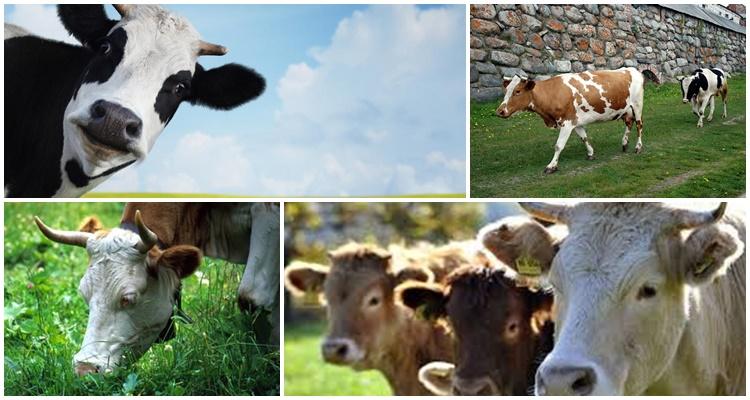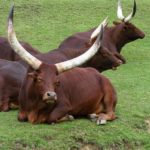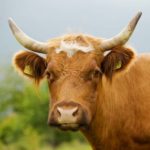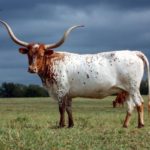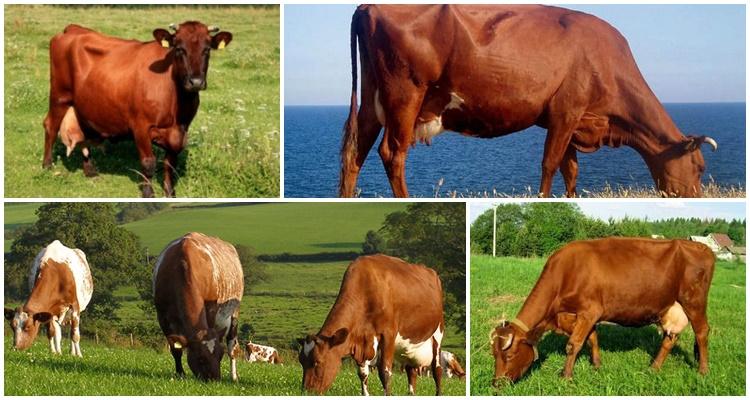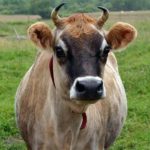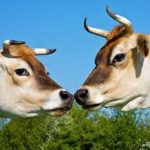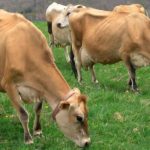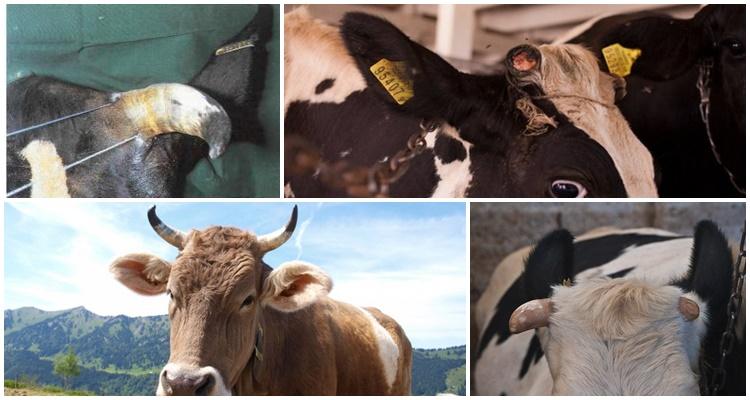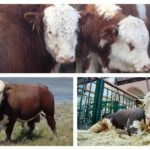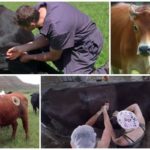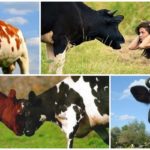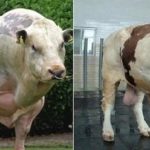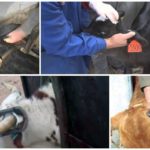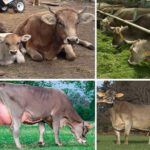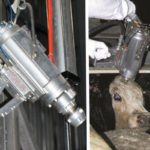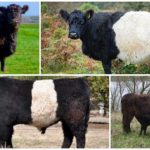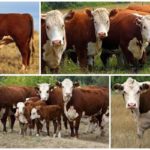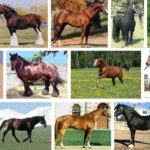Thanks to the work of breeders, many unusual breeds of cattle have appeared. When purchasing a pet, an experienced farmer will inquire not only about the productive qualities of the cow, but will also check whether the new cow has horns. Modern livestock breeders are trying to get rid of horny processes on the heads of animals. The dehorning procedure helps prevent serious injuries to cows and ensure the safety of their owners.
Why does a cow have horns?
It's hard to imagine a cow without a pair of sharp horns. Of course there are breeds of polled cows, but it is rare to find them. Nature did not give the cow sharp claws and strong teeth, but gave them horns. The paired organ serves as the cows' only protection from predators. In addition, the horny processes have another purpose:
- The horns on a cow's head are a means of attracting the attention of bulls.
- Males use formidable weapons to successfully fight for dominance among their own kind. The leading place is invariably occupied by the owner of the largest horny processes.
People use pet horns as a holding device:
- Having tied the cow by the horns, the owners carry out therapeutic and caring procedures.
- On an improvised leash, the animal is led in any direction. When tethered, the cow meekly follows the man.
- An experienced farmer only needs one look at the horns of a cow to determine the exact age of the animal.
In bulls, the paired organ is more developed than in the fair sex. In some individuals, the length of the horns reaches 65-70 cm.
Anatomical structures
The sharp horns of the cow have a complex structure. The outer part of the corneal process is a capsule consisting of numerous stem cells. It consists of epidermal cells. This is the part of the horn that everyone is used to seeing.
The dermis is hidden under the epidermis layer. It is penetrated by a network of blood vessels. The dermis reliably connects the frontal bones to the base of the horn and provides blood supply to the outer cover of the organ. Beneath the dermis layer is loose connective tissue.
The corneal process is divided into parts:
- Base. This part contains the root of the horn.
- Body. The largest, central part of the organ. As a rule, it is the body of the horn that is injured.
- The apical part of the corneal process.There are no blood vessels or numerous nerve endings here, so injury to this part of the horn will not bring suffering to the pet.
Newborn calves have only tubercles - the rudiments of horns. Horns come in different colors. It is not uncommon to find white, black, brown or dark gray shoots.
Determining age by horns
The condition of the horny processes can be used to judge the age of the cow. True, this method is not suitable for young chicks. Counting is possible only thanks to the horns of a pet that has calved repeatedly. Each calving of an animal is accompanied by hormonal changes in the pet’s body. The epidermis layer begins to actively grow or, conversely, become thinner. The process ends with the appearance of another ring on the cow’s horns. The cow breeds offspring no more than once a year, so the number of marks exactly matches the age of the animal.
Do I need to do anything if the animal breaks its horn?
If a pet is deficient in nutrients and vitamins, its horny processes become fragile and break easily. The same story happens with animals that have reached a respectable age. Horns serve as an indicator of the animal's health status. A lack of vitamins is indicated by delamination of the outer covering on the horns.
The inside of the organ is lined with numerous layers of skin. They protect the bone from damage and boast an excellent blood supply. Experts call these layers of skin the sheath. When the protective cover is injured, the wound bleeds and causes suffering to the pet. The cow may cry in pain. The consequences of injury can be severe.When a fracture occurs, the area of the frontal bone opens and the brain is exposed. In this situation, you cannot do without the help of a veterinarian.
If the body of the horny process is fractured, first aid is provided to the cow:
- The wound is thoroughly washed and disinfected. Then the injured area must be tightly bandaged. In some cases, bleeding is stopped with a tourniquet applied to the base of the broken corneal process.
- The diseased organ is anesthetized and cut down just below the fracture site.
- Swabs with healing preparations and a clean, disinfectant bandage are applied to the sawed-off stump.
The most dangerous organ injury is a fracture of the base of the horn. In this case, the veterinarian must take emergency measures. The procedure is performed under anesthesia. The animal is firmly restrained. The broken horn is sawed off and the bone fragments are aligned.
Then swabs soaked in a disinfectant and a sterile bandage are applied to the treated wound.
How to remove horns from a cow
Injuries to the horns bring physical suffering to pets, so farmers often resort to early amputation of the horny processes of animals. As a rule, small calves are subjected to the procedure. At a young age, the operation is almost painless, and the wounds heal quickly.
Calves are dehorned in different ways:
- Bloodless amputation of horn rudiments using a special tight ring. The procedure is done under local anesthesia. The calf's horny processes are tightened with tight rubber donuts. Thus, the blood supply to the horny capsules is completely stopped, and the organs stop growing. After 7-9 days, the dead horn buds fall off.
- Removing horny processes using a sheet saw. The operation is performed under local anesthesia.Before amputation, large blood vessels are clamped. After removing the shoots, the wounds are treated with an antibiotic and a bandage is applied. With this method of dehorning, the wound healing process takes a long time. The animal will need at least 2 months to fully recover.
- Adult animals often undergo partial amputation of their horns. In this case, only the tips of the horny processes are cut off. There are no blood vessels or nerve endings in these places, so pets undergo the operation painlessly.
- Removing horns using chemicals. The procedure is performed on very young calves. The maximum age of babies should not exceed 3 weeks. The rudimentary tubercles are treated with a chemical and sealed with a plaster. This method is not particularly popular due to pain and possible complications.
- Amputation of horns using electricity. The operation is performed on calves up to two months of age. The procedure is carried out using a device called an electrothermal cautery. Within 4-5 seconds, the rudimentary tubercles of the horns are cauterized at a temperature of 1000 degrees. After 10-14 days, the dried horny processes fall off.
Use of cut horns
People use horns to make decorative items and jewelry. Products carved from animal bones find a place in museums and exhibitions. In the Caucasus, wine vessels are made from the horns of cow cows. Such cups are traditionally used during celebrations of significant events.
Breeds of cows without horns
Hornlessness of cows is not always achieved artificially. Some breeds of animals initially lack horny processes. There are only small tubercles on the heads of these cows. Such animals are called polled.The name comes from the word “komel”, which means “small block of wood” or “growth”.
Polled cows are the fruit of many years of work by breeders. They are in no way inferior to their horned fellow tribesmen. The absence of horns does not affect milk yield and the amount of fattened weight. Polled cows are fertile and do not require special housing conditions.
The following breeds are popular among professional livestock breeders:
- Russian (komolaya). The unique breed was developed by crossing Kalmyk cows with Aberdeen dogs. Strong, muscular animals are champions in meat production. The product yield is 70-80%. Bulls of the Russian breed easily reach 1300 kg.
- Redpole. Representatives of the English meat and dairy breed are not afraid of hot climates. Red-brown cows produce about 4.5 thousand liters per year. The weight of an adult bull reaches 800 kg; cows gain no more than 600 kg.
- Aberdeen Angus. A distinctive feature of the breed is the pleasant roundness of all parts of the body. The cows are known for producing quality beef.

